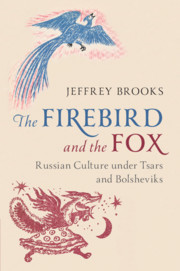Book contents
- Reviews
- The Firebird and the Fox
- The Firebird and the Fox
- Copyright page
- Contents
- Color Plates
- Figures
- Acknowledgments
- Introduction: An Age of Genius
- Part I Emancipation of the Arts (1850–1889)
- Part II Politics and the Arts (1890–1916)
- Part III The Bolshevik Revolution and the Arts (1917–1950)
- Epilogue
- Notes
- Index
- Plate Section (PDF Only)
Part III - The Bolshevik Revolution and the Arts (1917–1950)
Published online by Cambridge University Press: 05 October 2019
- Reviews
- The Firebird and the Fox
- The Firebird and the Fox
- Copyright page
- Contents
- Color Plates
- Figures
- Acknowledgments
- Introduction: An Age of Genius
- Part I Emancipation of the Arts (1850–1889)
- Part II Politics and the Arts (1890–1916)
- Part III The Bolshevik Revolution and the Arts (1917–1950)
- Epilogue
- Notes
- Index
- Plate Section (PDF Only)
Summary
The October Revolution in 1917 profoundly shocked the cultural ecosystem. The new authorities recast notions of freedom, of the arts, and of the public. Links between and among audiences at different levels that had thrived in the prerevolutionary cultural market were dismantled. Over time the government imposed strictures on culture requiring alignment with political directives. By 1934, the official policy of Socialist Realism was mandatory and compliance enforced by rewards and terror. The early years of revolutionary ferment yielded aesthetic innovation of the highest order, yet the mounting pressures took their toll on creativity. Writers, artists, and performers responded variously. Some took cover in works employing irony and in the (somewhat) safer terrain of children’s literature. By seeding children’s literature with values counter to those practiced by Soviet officialdom, selected writers and artists spread counter-values to a new generation. They worked with the guile of the fox, the flight of the firebird, and, perhaps, the recklessness of the Fool. By keeping alive Russian stories of wise Fools, sentient animals, and magical powers, their creators carried forward folkloric traditions barred from the reigning Socialist Realism. In doing so, they protected limited public space for artistic innovation.
Keywords
- Type
- Chapter
- Information
- The Firebird and the FoxRussian Culture under Tsars and Bolsheviks, pp. 167 - 262Publisher: Cambridge University PressPrint publication year: 2019



